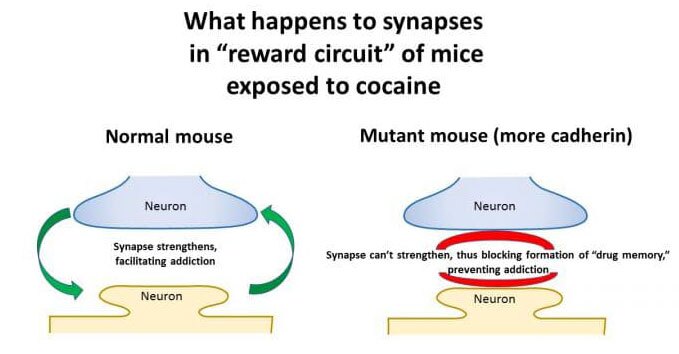Why do some cocaine users become addicts while others don't? One popular theory attributes it to poor judgement, which some studies suggest is due to the way the drug hijacks various parts of the brain, preventing addicts from learning from past mistakes or differentiating between right and wrong. However, the accidental creation of a cocaine-resistant mouse suggests otherwise – that some people might actually be genetically predisposed to drug addiction more than others.
Cadherins are membrane proteins that help cells to stick together. In the brain, they are responsible for strengthening synapses between neurons, an important function for all kinds of brain-controlled activities, from breathing and walking to, in this case, learning about the high induced by cocaine. Previous studies have suggested a connection between substance dependence and genetic mutations associated with cadherin and cell adhesion.
To test this hypothesis and find out if people with these mutations are indeed more susceptible to cocaine addiction, researchers at the University of British Columbia (UBC), led by neuroscientist and lead researcher Shernaz Bamji, created mutant mice that had been genetically engineered to produce higher levels of cadherin in their brains. Together with a control group of normal specimens, the mice were alternately injected with cocaine and saline over a period of a few days.
After each administration, they were placed in a specific compartment in a cage with three distinct chambers so that they would associate the drug and solution with a particular space. After nearly a week of injections, the mice were placed in the cage and allowed to wander freely.
This is where things get interesting: contrary to what the researchers were expecting, the genetically engineered mice were indifferent to the compartment associated with cocaine, unlike the other test group. Later, when they examined the brain tissue of the mutant mice, the researchers found that the extra cadherin had greatly reduced the behavioral conditioning that cocaine induces by blocking the movement of a specialized neurochemical receptor from the cell's interior to the synaptic membrane.
Without this particular receptor in place, a neuron can't receive signals from adjoining neurons. As a result, the synapses don't strengthen and the pleasurable memory does not "stick," explain the researchers.

"Through genetic engineering, we hard-wired in place the synapses in the reward circuits of these mice," says graduate student Andrea Globa, who was part of the study. "By preventing the synapses from strengthening, we prevented the mutant mice from 'learning' the memory of cocaine, and thus prevented them from becoming addicted."
This is not the first time that scientists have put forth the theory that genetics and biochemistry make some people more vulnerable to substance abuse than others. Back in 2008, researchers at the University of Cambridge suggested drug users with a "genetic vulnerability to addiction" were more likely to lose control and become addicts.
In particular, the study proposed a link between increased impulsive behavior in rats and low levels of a particular type of dopamine receptor in the front section of the reward center of the brain known as the striatum. The scientists, led by experimental psychologist Jeffrey Dalley, argued that the more impulsive a user, the more likely the individual was to become addicted to the drug.
What all this goes to show is how complex the issue of drug addiction is and that there is a need for personalized therapies that target addicts' different brain structures. That said, while this UBC study might have brought to light cadherin's behavioral impact, this does not mean curing cocaine addiction is simply a matter of increasing its levels in a user's brain – at least not for human addicts, anyway. While a cadherin boost might stop the brain from getting acquainted with a cocaine-induced rush, it is also likely to impair other day-to-day learning activities, which isn't an ideal trade-off unless the subject has no intention of being a productive member of society ever again.
"For normal learning, we need to be able to both weaken and strengthen synapses," explains Bamji. "That plasticity allows for the pruning of some neural pathways and the formation of others, enabling the brain to adapt and to learn."
Where these findings could be helpful is in helping health authorities predict who is more vulnerable to drug addiction. And while a cure remains elusive, knowing how cadherin affects substance abuse could point researchers in the direction of a molecule that blocks formation of a memory of a drug-induced high, while not interfering with the ability to remember important things, says Bamji.
The video below illustrates the difference in mice behavior and the study was published in Nature Neuroscience.
Source: UBC





![The Ti EDC [everyday carry] Wrench is currently on Kickstarter](https://assets.newatlas.com/dims4/default/0ba225b/2147483647/strip/true/crop/4240x2827+0+3/resize/720x480!/quality/90/?url=http%3A%2F%2Fnewatlas-brightspot.s3.amazonaws.com%2F59%2Fb2%2F6a6fdd0348a8bfdad88bbcefec53%2Fdsc03572.jpeg)